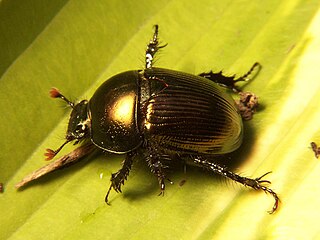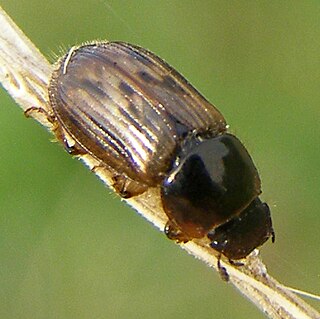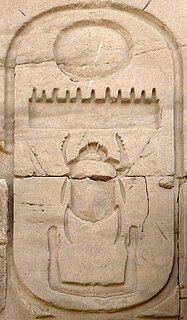
Beetles are a group of insects that form the order Coleoptera, in the superorder Endopterygota. Their front pair of wings are hardened into wing-cases, elytra, distinguishing them from most other insects. The Coleoptera, with about 400,000 species, is the largest of all orders, constituting almost 40% of described insects and 25% of all known animal life-forms; new species are discovered frequently. The largest of all families, the Curculionidae (weevils) with some 70,000 member species,
belongs to this order. Found in almost every habitat except the sea and the polar regions, they interact with their ecosystems in several ways: beetles often feed on plants and fungi, break down animal and plant debris, and eat other invertebrates. Some species are serious agricultural pests, such as the Colorado potato beetle, while others such as Coccinellidae eat aphids, scale insects, thrips, and other plant-sucking insects that damage crops.

The family Scarabaeidae as currently defined consists of over 30,000 species of beetles worldwide, often called scarabs or scarab beetles. The classification of this family has undergone significant change in recent years. Several subfamilies have been elevated to family rank, and some reduced to lower ranks. The subfamilies listed in this article are in accordance with those in Bouchard (2011).

Khepri is a god in ancient Egyptian religion who represents the rising or morning sun. By extension, he can also represent creation and the renewal of life.

Polyphaga is the largest and most diverse suborder of beetles. It comprises 144 families in 16 superfamilies, and displays an enormous variety of specialization and adaptation, with over 300,000 described species, or approximately 90% of the beetle species so far discovered.

Scarabaeoidea is a superfamily of beetles, the only subgroup of the infraorder Scarabaeiformia. Around 35,000 species are placed in this superfamily and some 200 new species are described each year. Its constituent families are also undergoing revision presently, and the family list below is only preliminary.

Cow dung, also known as cow pats, cow pies or cow manure, is the waste product of bovine animal species. These species include domestic cattle ("cows"), bison ("buffalo"), yak, and water buffalo. Cow dung is the undigested residue of plant matter which has passed through the animal's gut. The resultant faecal matter is rich in minerals. Color ranges from greenish to blackish, often darkening soon after exposure to air.

Geotrupidae is a family of beetles in the order Coleoptera. They are commonly called earth-boring dung beetles. Most excavate burrows in which to lay their eggs. They are typically detritivores, provisioning their nests with leaf litter, but are occasionally coprophagous, similar to dung beetles. The eggs are laid in or upon the provision mass and buried, and the developing larvae feed upon the provisions. The burrows of some species can exceed 2 metres in depth.

The scarab beetle subfamily Scarabaeinae consists of species collectively called true dung beetles. Most of the beetles of this subfamily feed exclusively on dung. However, some may feed on decomposing matter including carrion, decaying fruits and fungi. Dung beetles can be placed into three structural guilds based on their method of dung processing namely rollers, dwellers and tunnelers Dung removal and burial by dung beetles result in ecological benefits such as soil aeration and fertilization; improved nutrient cycling and uptake by plants, increase in Pasture quality, biological control of pest flies and intestinal parasites and secondary seed dispersal. Well-known members include the genera Scarabaeus and Sisyphus, and Phanaeus vindex.

Aphodiinae is a subfamily of the scarab beetle family, Scarabaeidae. Members of this subfamily are known commonly as the small dung beetles and many, but not all, are dung beetles. These beetles are found worldwide.
Datasoft, Inc. was a video game developer and publisher founded in 1980 by Pat Ketchum. Based out of Chatsworth, California, Datasoft ported games from arcade systems to personal computers and acquired licenses for games from famous movies and TV shows. Some original titles were also produced.

Scarabaeus sacer, common name Sacred scarab, is a species of dung beetle belonging to the family Scarabaeidae.

Aphodius is a genus of beetles in the Scarabaeidae family. In most species both the adults and larvae are coprophagous although some species have herbivorous or saprophagous larvae. Aphodius species typically dominate dung beetle communities in north temperate ecosystems. Most species are functionally classified as endocoprids, also known as dwellers, because the larvae live and feed within the dung pat itself.
The Australian Dung Beetle Project (1965–1985), conceived and led by Dr George Bornemissza of the Commonwealth Scientific and Industrial Research Organisation (CSIRO), was an international scientific research and biological control project with the primary goal to control the polluting effects of cattle dung.
George Francis Bornemissza was a Hungarian-born entomologist and ecologist. He studied science at the University of Budapest before obtaining his PhD in zoology at the University of Innsbruck in Austria in 1950. At the end of that year he emigrated to Australia. There he first worked in the Department of Zoology at the University of Western Australia for 3 years, before pursuing a career with the Commonwealth Scientific and Industrial Research Organisation (CSIRO). Bornemissza is most noted for his work on the Australian Dung Beetle Project (1965–1985) while working with CSIRO’s Division of Entomology.
In 2001 he was awarded the Medal of the Order of Australia for his services to Australian entomology. Bornemissza has written several papers published in notable journals and books and has contributed an extensive collection of mounted beetle specimens to the Australian public.

The flightless dung beetle is a species of dung beetle endemic to a few areas of South Africa, including the Addo Elephant National Park and the Buffalo Valley Game Farm. It is the only species in the genus Circellium. The loss of flight allows the beetle to use the empty space below the elytra as a carbon dioxide storage tank, creating a unique breathing mechanism which conserves water, a valuable survival trait in the arid regions it lives in.

Insects have long been used in religion, both directly and as images or symbols.














